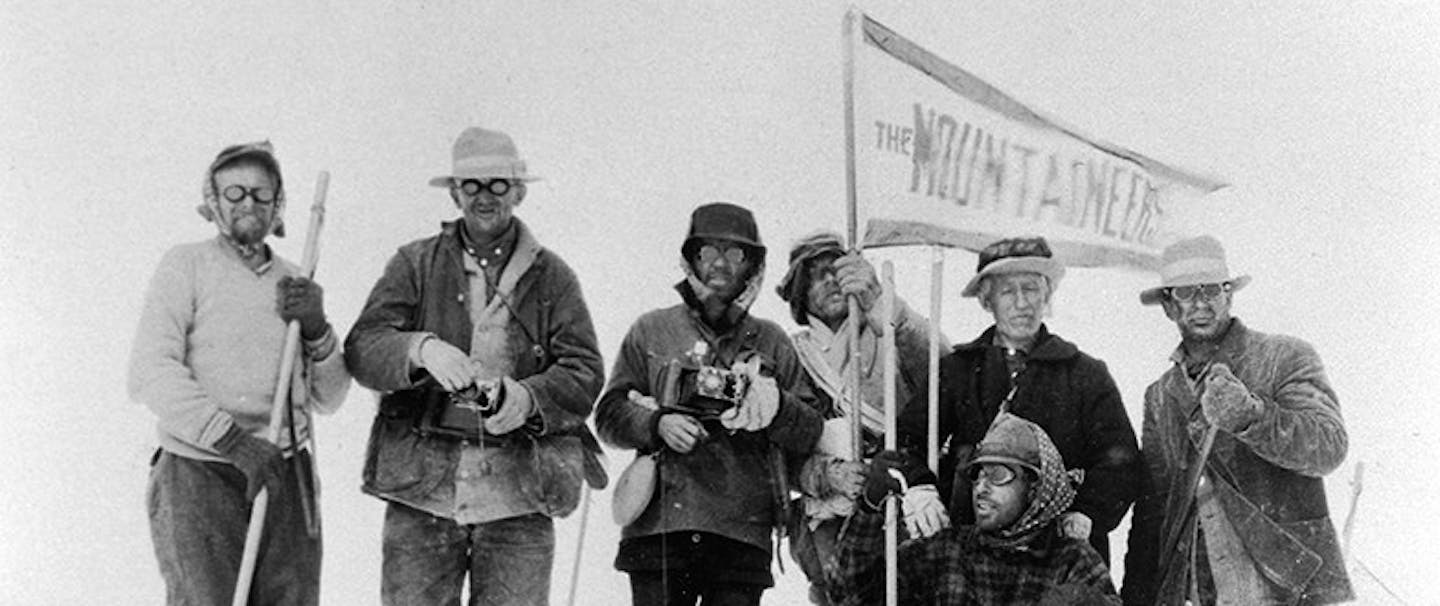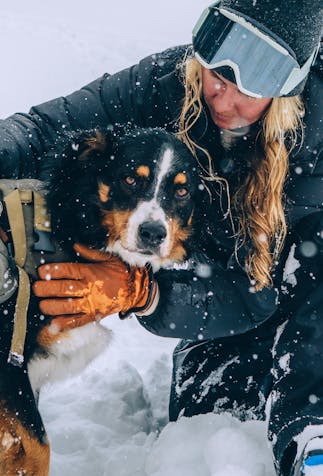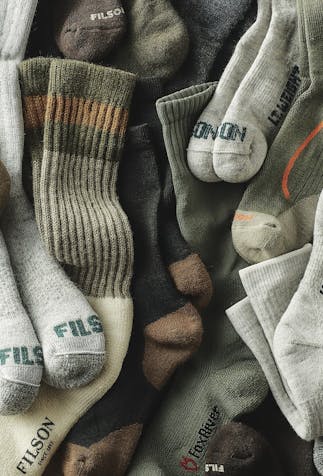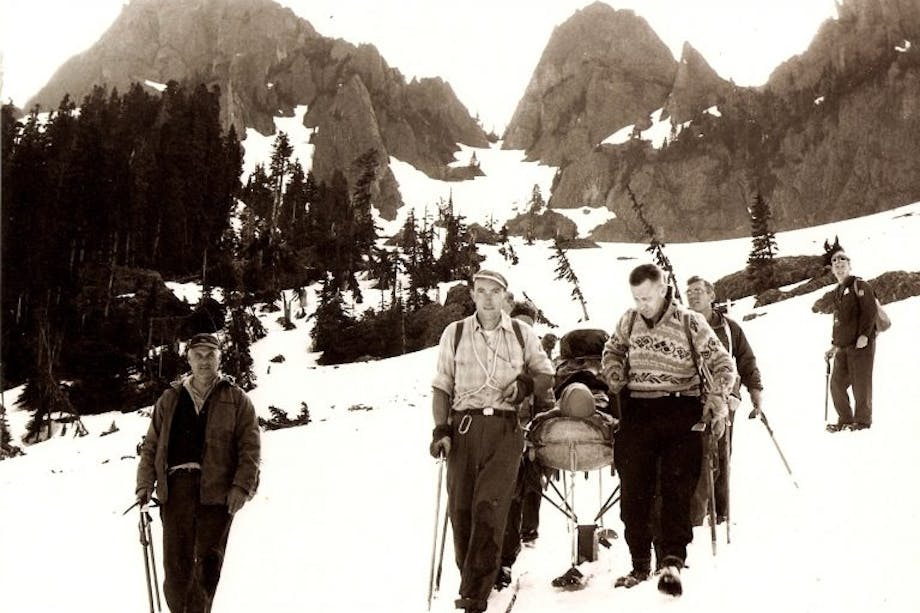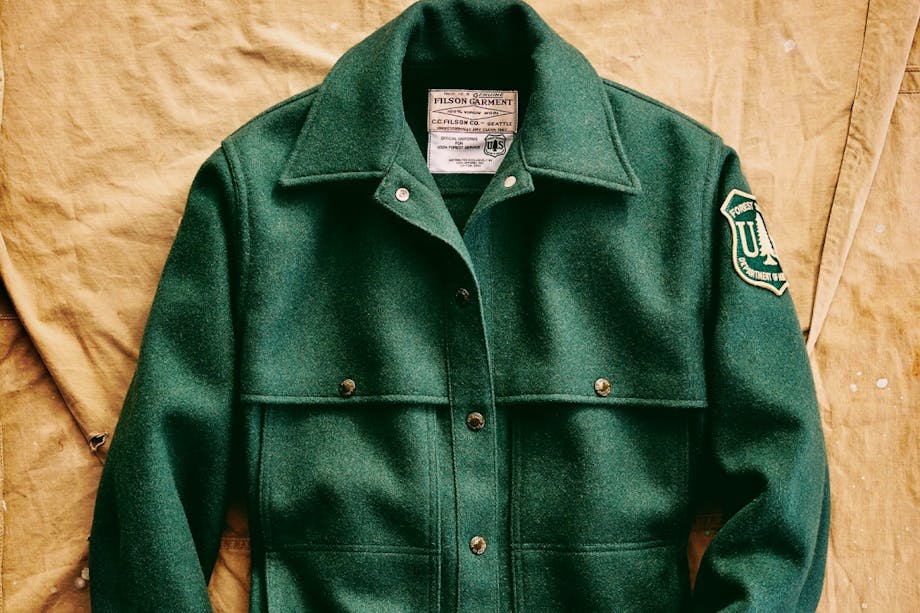Prehistory to Birth of Mountaineering (4000 BCE–1786 CE )
Humans have climbed mountains since they first crossed the Alps or left religious offerings in the highest heights. But it wasn’t until the mid-18th century that Europeans—blessed with surplus time on their hands due to wealth generated by manufacturing—turned their gaze to the tops of mountains. It’s no coincidence that 1760—the year pegged as the beginning of the Industrial Age—saw a young Swiss scientist named De Saussure inadvertently birthing the sport of mountaineering. As the story goes, De Saussure was so taken by the shimmering beauty of Mont Blanc (15,777 ft), that he granted a monetary reward to the first person who would climb it. What followed was the first summit climbed for sport alone and the advent of true mountaineering.

Mountaineers climbing in snow, August 11, 1913. Photo provided by: University of Washington, Mountaineers Collection
Mountaineering Attire – Prehistory
The mummified body of the “Tyrolean Iceman” named Ötzi was discovered high in the Alps (circa 10,530 ft) in 1991. His clothing tells us about state-of-the-art mountaineering attire of 3400 BCE and is described as “the height of Copper Age fashion.” He wore a woven grass mantle, waterproof leather shoes, a coat and loincloth of sheepskin, leggings of goatskin, a belt, and a bearskin cap with leather chin strap.
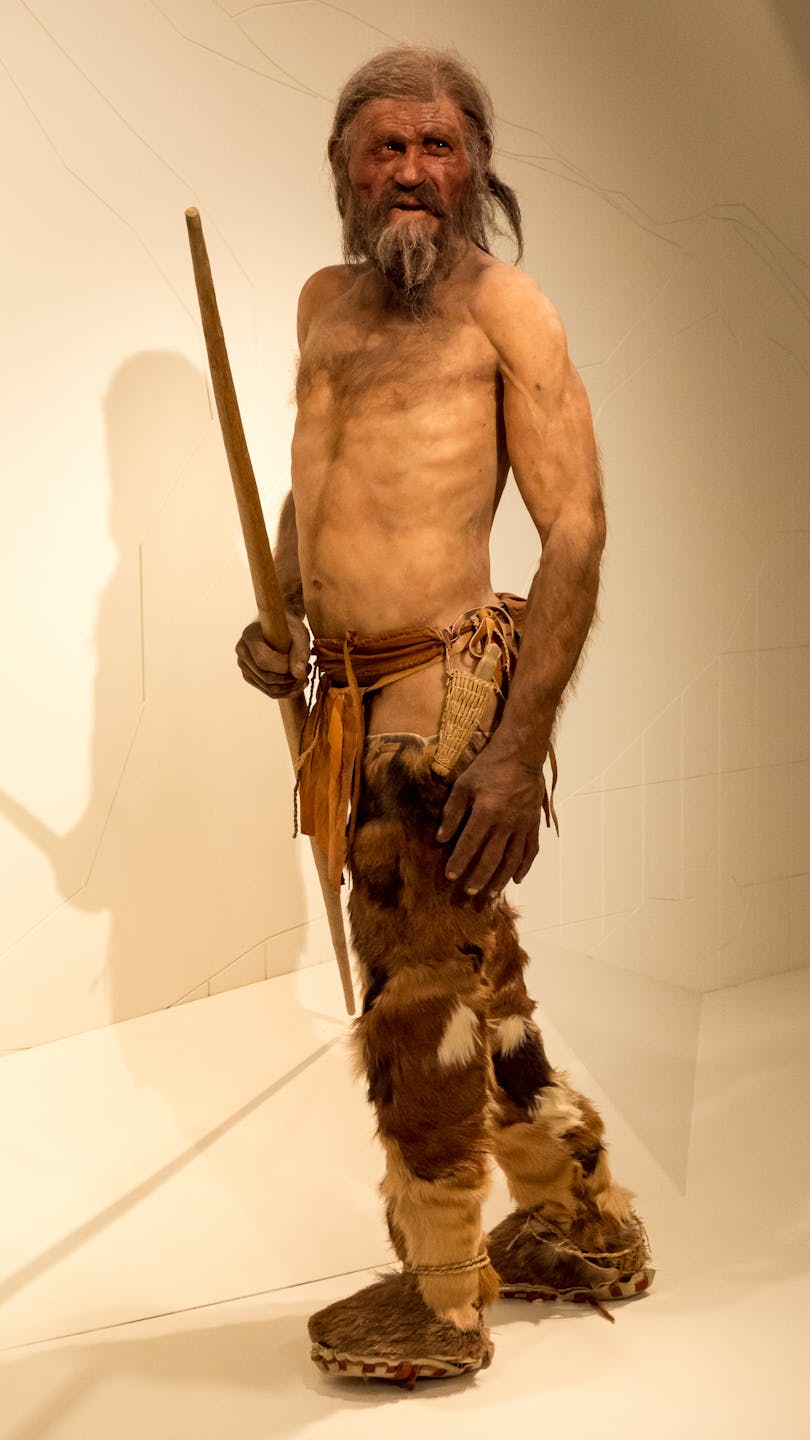
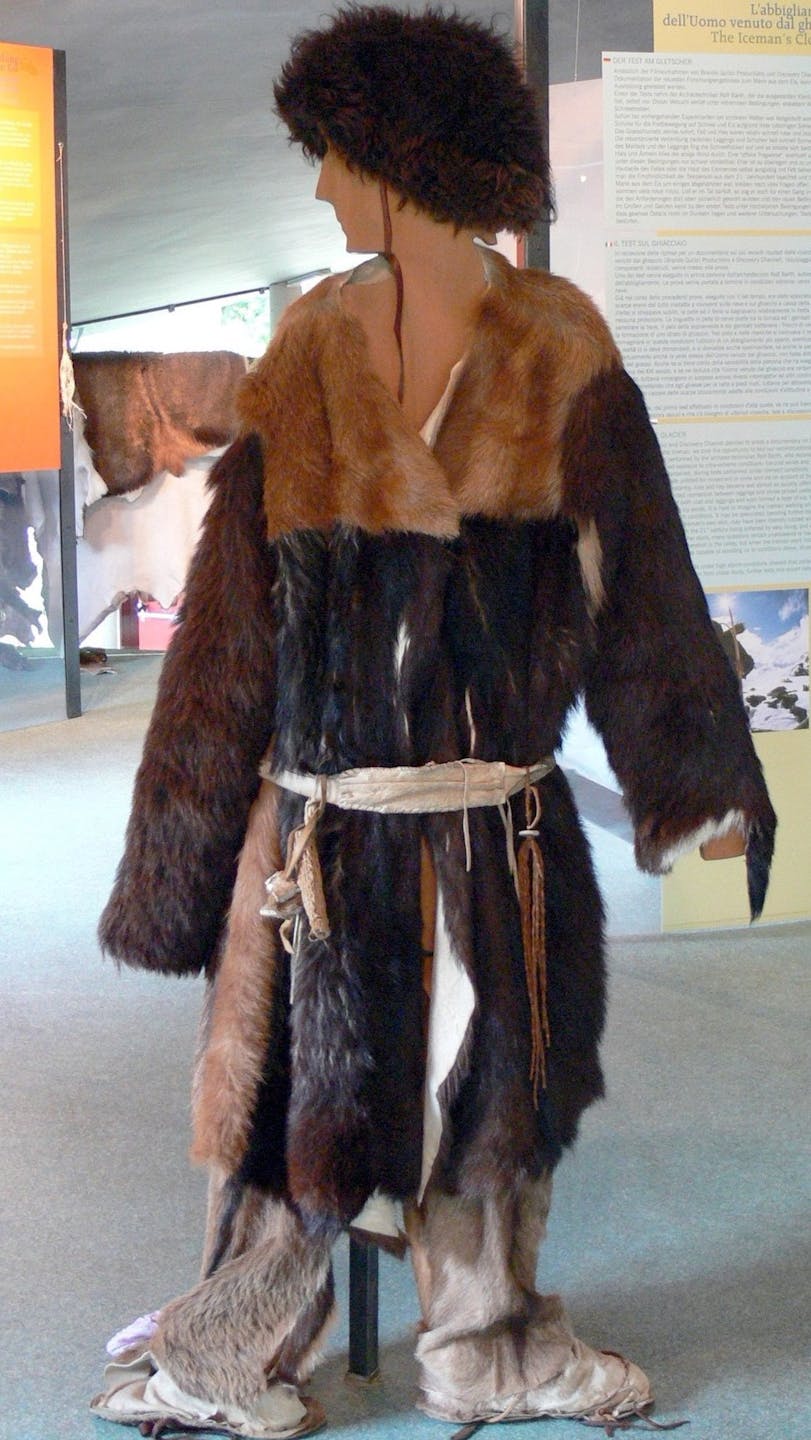
Photos provided by: South Tyrol Archaeology Museum
Early Mountaineering Attire
Jacques Balmat and Dr. Michel Paccard ushered in the sport of mountaineering when they summited Mont Blanc on August 8, 1786. They were “dressed as though for a valley stroll… and their only equipment a long wooden pole tipped with an iron ferrule.” Later refinement of clothing systems led to a simple expediency of layering the regular clothing of the day. Oversized wool coats, waistcoats, tall leather boots, and layers of stockings were de rigueur.

Born in Dublin on 26 June 1860, Elizabeth Hawkins Whitshed was an Irish pioneer of mountaineering. In 1907, became the first president of the Ladies Alpine Club.
The Golden Age of Alpinism and Beyond (1800–1913)
The Golden Age of Alpinism followed on the heels of the Mont Blanc climb, with most major summits in the Alps climbed during this period. Attention also turned to the unexplored. The urge to scale the summits spread to the Americas, Africa, the Andes, and the Himalayas. In North America, Mount Saint Elias (18,008 ft) was climbed in 1897—smack dab in the middle of the Klondike Gold Rush. Denali (20,310 ft) provided the next major inspiration. After several failures and one fraudulent summit claim, two dog mushers and a priest led by an Episcopal Archdeacon scaled the peak in 1913. Denali was not only the highest mountain in North America but also so far north that its atmospheric conditions rivaled the Himalayas.
Mountaineering Attire of the Golden Age and Beyond
The typical mountaineering outfit of the Golden Age consisted of wool and cloth layers, “enough for three men,” topped with a straw hat, “a pair of spectacles, and a green gauze veil.” This was “conforming to the belief that safety lay in wearing as much as possible.”
Regional clothing variations sprung from gender and what was at hand. In America, on Pikes Peak (14,115 ft), mid-19th-century ascents saw ladies in bloomers and men accessorized in beaver pelts. In the case of Denali, one summiteer added a “blanket around his shoulders to protect him from 62 degrees of frost.”
The late 1870s saw the rise of women in mountaineering and it was in this realm that clothing saw some innovation and adaptation. Initially, dresses for women were a social requirement and were made of light wool or alpaca so as to “not look utterly forlorn when it has once been wetted and dried.” To adjust the hem for rugged terrain, “…small rings should be sewn inside the seams of the dresses and a cord passed through them… that the whole dress may be drawn up at a moment’s notice to the required height.”
The Golden Age ended with virtually no changes in clothing that was “…little different from those worn for a winter walk at home.” Well into the 20th century, men’s mountaineering attire still leaned heavily on tweed jackets and wool, accessorized by goggles, an assortment of floppy headgear, and scarves.

The 1921 Everest Expedition - Mallory at right on rear row, Bullock at left on rear row.
New Heights in the Interwar Era (1918–1939)
After World War I, the first 8000-meter peaks were attempted in the Himalayas, including forays onto Everest (29,029 ft). Several 7000-meter peaks were climbed, including Nanda Devi (25,643 ft) and Kamet (25,446 ft). In 1938, the North Face of the Eiger (13,015 ft) was climbed, ushering in unheard of difficulty in deadly surroundings. A year later, a Polish team climbed Nanda Devi East (24,390 ft), considered by Tenzing Norgay as harder than Everest. These bold new climbs and cutting-edge progress came to an abrupt end at the outbreak of World War II.
Mountaineering Attire – Interwar Era
Little changed in mountaineering attire. Wool, cotton, and natural fibers still held sway. Wind and waterproof canvas developed for ocean travel and drill cloth (tweed) were again layered to provide protection and insulation. Wool caps and balaclavas replaced the floppy sun hats of the previous era.

Andrew Irvine & George Mallory
Mountaineer George Mallory disappeared 800 feet from Everest’s summit in 1924. His body was discovered in 1999 and revealed clothing made of gabardine, wool, cotton, and silk. A recent project replicated Mallory’s clothing and tested the outfit on Everest. Researchers found the gear “highly effective at providing protection at high altitude… excellent at trapping air next to the skin…,” and “…lighter than modern gear.” Most telling was that, while it was being tested, “all the other climbers thought the (replica) jacket was stylish and wanted to know where they could buy their own versions of the clothes!”
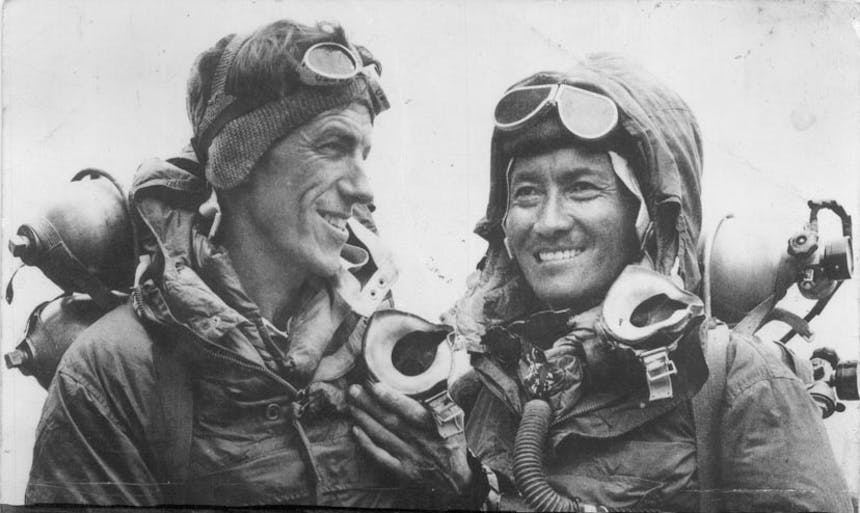
29 May 1953 Tenzing Norgay and Edmund Hillary after successfully completing the first ascent of Mount Everest at 11.30am.
The Modern Era – To the Top of the World and Beyond (1953–1980)
The big news of the immediate post-war was the 1950 first ascent of Annapurna (26,545 ft) by a French team. This was the first 8000er to be climbed. This feat was followed by Hilary and Norgay’s success on Everest in 1953. This Everest expedition applied logistical lessons learned in WW II and typified the large, military-style national endeavors. By the 1970s, the activity of climbing diversified into individual pursuits on rock and ice. These in turn elevated technical standards within alpinism. The attire of the climber developed into myriad offshoots, each providing specific performance for each discipline.
Mountaineering Attire – The Modern Era
World War II and the ensuing years saw better oxygen gear, an endless supply of surplus nylon ropes, and cheap pitons. The synthesis of synthetic fibers from petroleum derivatives made clothing lighter and more resistant to water and wind. Pile and fleece jackets, sweaters, and fuzzy pants became effective insulating layers that, unlike cotton, would stay warm even when wet. Blends of synthetic and natural fibers led to fabrics that combined the best of both worlds. The advent of waterproof coatings and waterproof/breathable laminates in the 1970s led to a further evolutionary step in mountaineering attire.

Willi Unsoeld and photographer Barry Bishop at promontory and future site of Camp 4W on Everest's West Ridge, with 25,000-foot Nupse in the background. Photo provided by: The Mountaineers / Tom Hornbein
Mountaineering – Today
Today, mountaineering is a pursuit that bears scant resemblance to the dozen or so activities within the overall sport of climbing. Indoor gym climbers, boulderers, sport climbers, and big wallers will likely never set foot on an icy peak, nor ever desire to. The “games” within climbing are often at odds and as different from each other as events within a sport like track and field. That said, all climbers share a common heritage. Regardless of stripe they can trace their passions back to the moment Balmat and Paccard set foot on the summit of Mont Blanc. At that moment, ascent for no other reason than ascent, was born.
Mountaineering Attire – Today
Throughout most of mountaineering history, clothing was an expression of what was available meeting the necessities of the environment. There wasn’t much choice. For several hundred years mountaineers wore what they could find. As climbing got harder and more serious it’s tools, techniques—and clothing—became more specialized. Form evolved to follow function.
Though climbing attire can be a cotton hoody, logo t-shirt, and blue jeans, mountaineering clothing is so specialized that it’s existence borrows from cutting edge technology and fabrication. Gore-Tex (used in space suits), Kevlar (used in body armor), electric heating, and touchpad-friendly gloves became an expectation rather than an innovation. The look and features have been snapped up by mainstream clothing brands and adapted for the layperson. In turn, a distinct mountaineering style has trickled into work wear and street wear. We’ve come full circle.
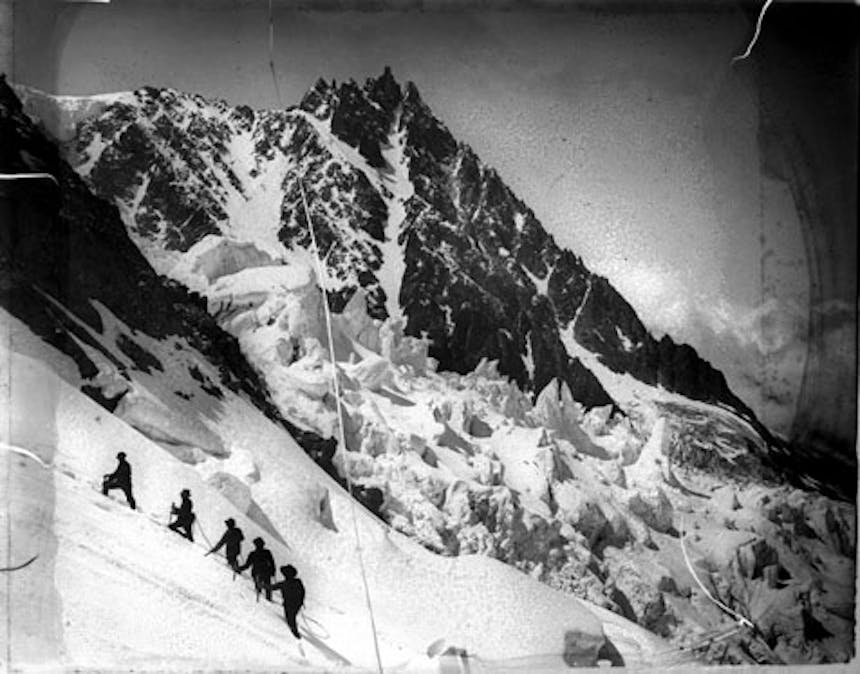
Rope mountaineers on the Mont Blanc. Photo provided by: Bibliothèque de Toulouse
